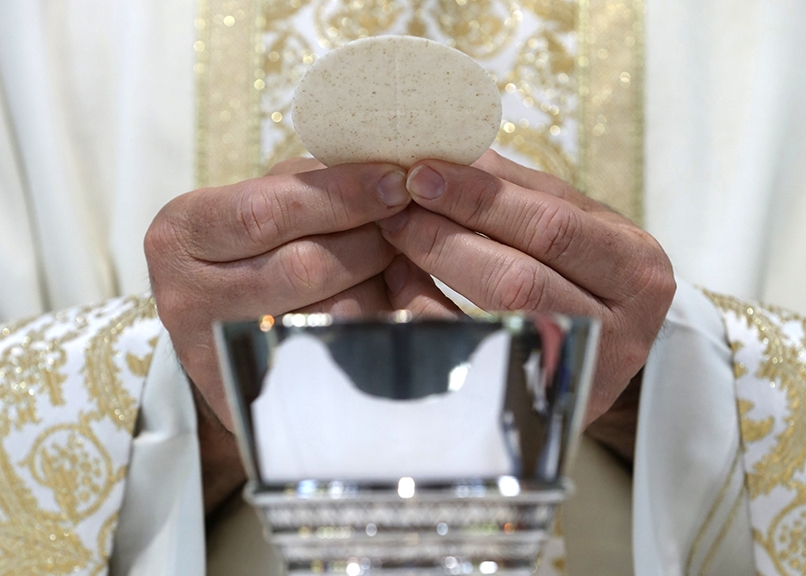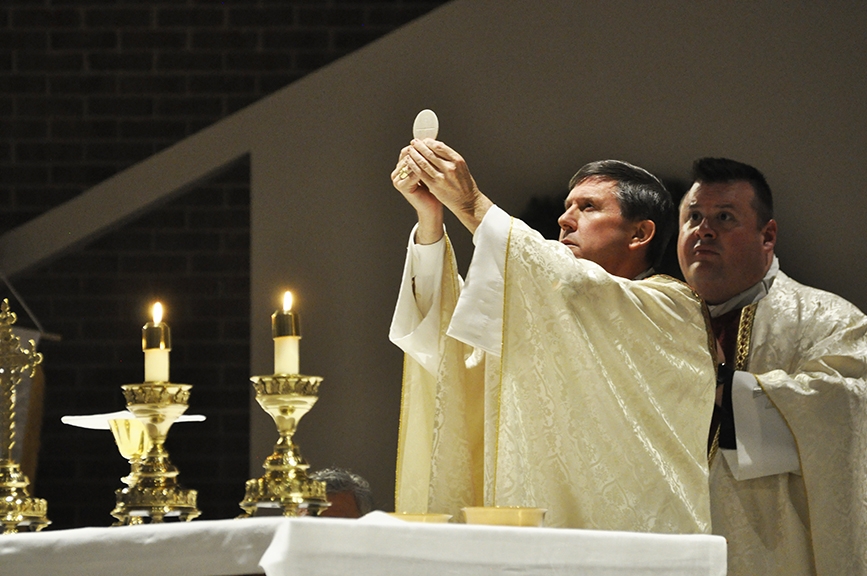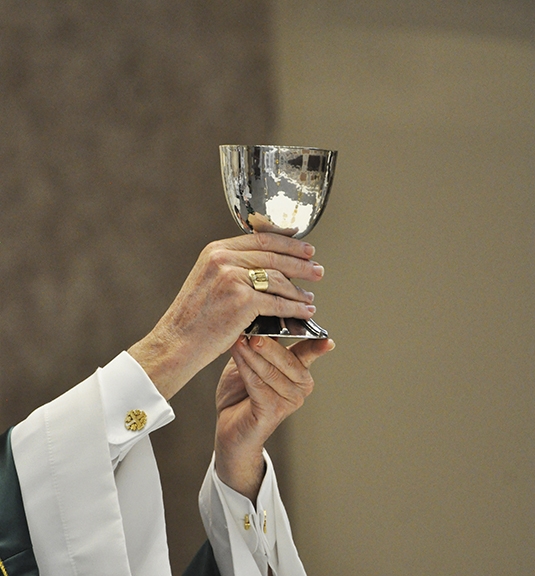
“This is my body given for you. … This is my blood, which is shed for you.” (Luke 22:19-20)
These words spoken by Christ at the Last Supper are the source and summit of the Catholic faith as he instituted the gift of himself in the Eucharist.
“On Holy Thursday, the Lord institutes the memorial of his passion and death, which will take place on Good Friday,” said Father John Hammond, vicar general and judicial vicar of the Diocese of Nashville and pastor of St. Patrick Church in South Nashville. “Friday is the content of the Holy Eucharist. The cross is what happens on Good Friday and when the Church celebrates Mass, that’s the sacrifice of Christ perpetuated on down through the ages. The Mass is the unbloody re-presentation of the single bloody sacrifice of Christ.”
This core and central belief of the Catholic faith will be brought back to the forefront with a three-year Eucharistic Revival beginning on the Feast of Corpus Christi, which is Sunday, June 19.
The whole point of the revival is to re-establish and reignite the belief in the Real Presence,” said Dr. Brad Peper, director of the Office of Faith Formation, which is leading the initiative for the Diocese of Nashville.
“The Eucharist isn’t just a part of our lives on Sundays” added Jenny Haug, assistant director of catechesis for the Office of Faith Formation. “It is a part of our lives every day.”
The purpose
The initiative for a Eucharistic Revival came about because of a Pew study done in late 2019 that revealed that only 30 percent of Catholics believed in the Real Presence of Christ in the Eucharist.
“This stark reality inspired the bishops of the United States to action,” according to the official Eucharistic Revival website. “More than an event or a program, they envisioned a true revival to rediscover the source and summit of our faith through a deep commitment of prayer, pilgrimage and worship on the part of the entire Church in the United States.
“The advent of the pandemic only accelerated these plans, revealing their urgency and importance. Too many Catholics still have not returned to Mass to celebrate the central mystery of the Church,” the site continues. “Taking its title from the Bread of Life discourse in John’s Gospel … the Eucharistic Revival is not a step-by-step plan or series of meetings; it is a grassroots call and a challenge for every Catholic across the United States to rekindle the fire of love and devotion for the Eucharistic Heart of Jesus.”
Diocesan plans
Following the kick-off on Corpus Christi, diocesan initiatives will begin immediately on June 20, Haug said.
“It is what we are going to be doing to help the parishes in our diocese,” she said.
Initiatives will include a catechetical conference, which will last the full three years.
“In conjunction with the Eucharistic Revival, it is going to be three years diving deeper into the meaning of the Eucharist through catechesis, liturgical celebrations and prayer,” Haug said.
The Office of Faith Formation will also be collaborating with parishes and the priests in the diocese to find a point person in each parish.
“The only prerequisite is that they have this beautiful devotion to Jesus in the Eucharist already and that they are willing to encourage those that they know within their parish that we need to do this together,” Haug explained.
Additionally, “there will be catechetical resources made available diocesan-wide, retreats for lay leaders, and a catechetical conference each year focusing on different consecutive themes regarding the Real Presence of Christ in the Eucharist – presence, sacrifice and communion/consummation,” Peper added.
There will also be collaboration with religious education directors and the Catholic schools to plan curriculum that focuses more on the teaching of the Real Presence.
It will all culminate in the first National Eucharistic Congress in almost 50 years, from July 17-21, 2024, in Indianapolis.
“The Eucharistic Revival is a wonderful opportunity to renew our understanding of and enthusiasm for the Eucharist,” said Bishop J. Mark Spalding. “Our Church will be made stronger through all these activities.”
The Real Presence

Where does the belief in the Real Presence come into Catholic teaching? During the sacrifice of the Mass.
The climactic moment comes with the Words of Institution and is the moment when the bread and wine become the body, blood, soul and divinity of Jesus Christ, said Father Hammond.
In this moment, the priest echoes the words of Christ at the Last Supper, as the bread and wine are consecrated in a term known as transubstantiation.
Transubstantiation “means the substance has changed,” Father Hammond explained. “They are not bread and wine anymore. Even though they continue to have the appearance of bread and wine, they are not substantially bread and wine anymore.”
Then, in reverence the priest elevates the body and blood, and in that moment, two things are happening.
“One is the sacrifice is being offered up to God, is being lifted to God,” Father Hammond explained. “But also, the blessed sacrament is being shown to the people.
“The consecration has already happened, and at that point, it’s not the bread anymore,” he said. “It’s now the body, blood, soul and divinity of Christ, which is held up for the worship of the faithful. … We worship Christ and therefore we worship the blessed sacrament.”
Scriptural references
The evidence that Christ’s body and blood are fully present has several scriptural references beyond the core basis in the Last Supper, Father Hammond said.
One of the biggest is the Bread of Life Discourse in chapter six of John’s Gospel.
“Jesus said to them, ‘I am the bread of life; whoever comes to me will never hunger, and whoever believes in me will never thirst. … Amen, amen, I say to you, unless you eat the flesh of the Son of Man and drink his blood, you do not have life within you. Whoever eats my flesh and drinks my blood has eternal life, and I will raise him on the last day. For my flesh is true food, and my blood is true drink. Whoever eats my flesh and drinks my blood remains in me and I in him.’” (John 6:35; 53-56).
It’s also evident in his final words at the end of Matthew’s Gospel just before he ascended into heaven:
“And behold, I am with you always, until the end of the age” (Matthew 28:20).
“The Eucharist is the most profound way in which he hasn’t left us,” Father Hammond said. “It’s a wonderful gift that the Lord gives us.”
Receiving the body and blood
With the bread and wine now the body and blood, it’s time for the faithful to receive him, an act which comes with many graces.
The Catechism of the Catholic Church 1391-1401 lays out these graces, including its augmenting of our union with Christ; separating us from sin; strengthening our living charity, which wipes away our venial sins; preserving us from future mortal sins; and more.
And it comes no matter the form it’s in, separating the meaning of the sacrifice of the Mass and the sacrament of Holy Communion, Father Hammond said.
“The sacrifice of the Mass, which is when we go to Mass, the priest always, no matter what, has to consecrate both the bread and the wine as part of the sacrifice of the Mass. The sacrifice requires both because that’s what the Lord gave us,” Father Hammond said.
“Receiving the sacrament of Holy Communion only requires receiving under one species because it’s our belief that the whole Christ, body, blood, soul and divinity, is present under either appearance,” Father Hammond said. “Christ cannot be divided because he is glorified, he is in heaven, he cannot be split up. Wherever Christ is, he is fully there.”
There is no greater or lesser grace received if a person receives only one species or both, but “it is a fuller sign,” which is why the priest will also place a piece of the sacred body into the vessel holding the sacred blood, Father Hammond said.
“It is the mingling” of the body and blood, he said. “There are several layers of meaning to that, but the primary purpose is to show the unity of the body and blood of Christ to represent or manifest the fact that the body and blood of Christ are perfectly united.”
And it’s what makes the recent return of the cup so special.
Return of the cup

Because of the last two years dealing with the COVID-19 pandemic, access to the Eucharist has not always been easy. For several months, limited attendance at Mass left several without the chance to receive Christ in this most intimate form.
And even though regular Mass attendance has been back for more than a year now, it was only in the last few weeks that the people were offered the opportunity to receive the Sacred Blood.
“I think COVID woke us up when we couldn’t receive the Eucharist,” Haug said. “You don’t realize what you have until it’s gone, and we were longing for it.
“Then we were able to get back together and have the Eucharist, but we weren’t fully back because we weren’t receiving it from both species,” she said. “I think this revival and (the return of the cup) congruently shows that we’re back and we are going to make a difference. … It’s time to come back bigger and stronger.”
All about faith
To come back bigger and stronger, it is all about finding the faith.
“Faith is always a gift of God’s grace. It’s important for us not to rashly judge people who, for whatever reason, don’t have the gift of faith, but it is also our job as believers whenever we’re part of the Church” to represent the faith, Father Hammond said. “It is the responsibility of every Christian to teach and promote and spread the good news, and the Eucharist is a huge, central part of our good news. It’s so central to our faith that everything else rises and falls with it. … It is the source and summit.
“All of us have an obligation and an opportunity to spread and promote this teaching more effectively, and we can do that in a lot of ways,” he said. “We promote this teaching by going to Mass every Sunday. It is an act of faith in the Eucharist when we’re reverent in the presence of the Blessed Sacrament, when we genuflect, when we stay and pray before or after Mass, when we go to adoration, when we go to daily Mass.
“It always starts with ourselves. When there is something that isn’t right with the world, my first job is to convert myself or let the Lord convert me with his grace, and I think there is a realization on the part of the Church that we teach it more directly and explicitly and consistently,” he concluded. “Because faith is a gift and because it is an act of the intellect and the will, I can’t force anybody into belief, but my job is to live and present it as well as I can. This is the opportunity we have as a Church now to really lean into that obligation that we have.”
For more information about the Eucharistic Revival, visit eucharisticrevival.org.
For more information about diocesan initiatives, e-mail eucharisticrevival@dioceseofnashville.com.









